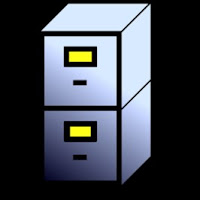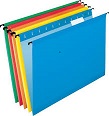-Lisa Rienerth - Guest Blogger - Kathy's co-worker
Does This Look Familiar?
Then it's time to organize your research!
You might be asking.."Why should I organize my research? I know where everything is!"
However, if you organize your research, it will improve your chances of successfully finding those elusive ancestors and help you break through those pesky brick walls!
AND.....
AND.....
 It is going to save you time! You won't be searching through piles of papers looking for that specific relative or old record you knew you put somewhere! You will be able to see what information you have and what you still need and where to find it, in just a glance! Names and places of repositories will be easily found and will come in handy if you need to search for records at a place you have already visited or communicated with.
It is going to save you time! You won't be searching through piles of papers looking for that specific relative or old record you knew you put somewhere! You will be able to see what information you have and what you still need and where to find it, in just a glance! Names and places of repositories will be easily found and will come in handy if you need to search for records at a place you have already visited or communicated with.It will save you money! If your records are organized, you will be less likely to order a record you already have. It will also help keep you from driving to a far off repository you already visited, but are unable to locate the information you found there.
It will keep your research focused! If you have your families sorted and all of your sources sorted by family surname, it will make it easier to not only record the information, but also to see what is missing. It helps you focus on one surname at a time, so you don't end up jumping from one person to the next and never really finding anything in particular for anyone.
Now that I have convinced you that it is a good idea to organize your research (at least I hope I have), let me show you some easy steps to start your organizing....and no...I won't tell you to hold it up and see if it gives you a spark of joy!
First, If you are a beginner, or you have only been doing your research for a few years, you will need some 2" binders. You want a binder for each SURNAME to keep all of the information that pertains to that family. Put the surname on the spine of the binder, that way when you have them shelved, you can see the name at a glance.
Use page dividers to keep the information organized within the binder.
 When you have so much information that it will no longer fit in the 2" binder or there isn't any room for one more binder on your shelves, it is time to move up to either a file cabinet or file box.
When you have so much information that it will no longer fit in the 2" binder or there isn't any room for one more binder on your shelves, it is time to move up to either a file cabinet or file box. You will then divide the surnames up into separate hanging files, using file folders to separate the information. Depending on how much information you have collected on a certain family, you may have to use multiple hanging folders for one surname. Some researchers color code their files or use color coded file labels to keep the names and information organized.
You will then divide the surnames up into separate hanging files, using file folders to separate the information. Depending on how much information you have collected on a certain family, you may have to use multiple hanging folders for one surname. Some researchers color code their files or use color coded file labels to keep the names and information organized.Keeping separate binders/files for each family and their records is just the beginning of your organizing.
The next step is using certain forms to keep your research recorded and organized. Kathy showed you how to use and how important Ancestral charts and Family Group sheets are. These are just two of the forms you need to keep in your surname binder or file.
Another important form is the Research Journal. The journal tracks the research you are planning to do and research you have completed. The Research Journal below is one I made in Microsoft Word with the Table tab.
 |
This Research Calendar is from Ancestry.com
 |
You can use any research form as long as it records who and what you are looking for, your plan to get the source, the date you completed your research along with the results. These types of forms help you keep organized in a few ways.
1. It keeps you focused on one person so you don't get distracted and forget who and what you are looking for.
2. It prevents you from repeating research you have already accomplished.
3. It retains information that you may need for future research. For example, ways to contact court houses or archives or how much you paid for a record.
TECHNOLOGY - Another Way To Organize!
From your device you can save your research to a flash drive. This is a handy device which you can take when you travel to research facilities. You will have all your information at your fingertips and most places you can download information to your flashdrive as you find it. Just remember the flash drive is only good for about 8-10 years and will need to be replaced so you don't lose your research.
Websites are another place you can download your information to. However, please read all the fine print to learn about their privacy settings and if there are any fees. A few websites which you might want to check out are: Ancestry.com, FamilySearch.org or MyHeritage.com. There are many more, but please be cautious with which one you use.
1. It keeps you focused on one person so you don't get distracted and forget who and what you are looking for.
2. It prevents you from repeating research you have already accomplished.
3. It retains information that you may need for future research. For example, ways to contact court houses or archives or how much you paid for a record.
TECHNOLOGY - Another Way To Organize!
Please remember....DO NOT throw away any of your hard copies! Technology does not replace what you have, it is in addition to what you have. Things can go wrong with technology and you could lose too much research because of it. However, you can't keep your hard copy safe from a catastrophe either. I am a believer of storing your research in as many places as possible.
A laptop or a tablet is a good place to save your research. You can scan your photographs and records and save them to files on your device.
From your device you can save your research to a flash drive. This is a handy device which you can take when you travel to research facilities. You will have all your information at your fingertips and most places you can download information to your flashdrive as you find it. Just remember the flash drive is only good for about 8-10 years and will need to be replaced so you don't lose your research.
External Hardrives are a great place to store your research and scanned photographs and documents. This way if your laptop's hard drive crashes or your USB gets lost you will still have your research.
Software is a wonderful tool to use to keep your research organized. Find a software program you feel comfortable with. The website, Top Ten Reviews, is a good place to start. It is a type of online consumer report and will have a list of the different software, a list of average prices and how well they do with certain options.
Software is a wonderful tool to use to keep your research organized. Find a software program you feel comfortable with. The website, Top Ten Reviews, is a good place to start. It is a type of online consumer report and will have a list of the different software, a list of average prices and how well they do with certain options.
 |
| Please disregard the prices. This is an outdated image. |
Websites are another place you can download your information to. However, please read all the fine print to learn about their privacy settings and if there are any fees. A few websites which you might want to check out are: Ancestry.com, FamilySearch.org or MyHeritage.com. There are many more, but please be cautious with which one you use.
The Mysterious CLOUD!
There really isn't anything mysterious.They work like your email accounts. The information you upload to the Cloud is kept on the company's server and you can access this information from the company's website on any device.
Just like the websites and software, do your homework. Search for what is available and talk to others who use this as a way of storing their information. A few providers are: Dropbox, Google Drive, Microsoft Onedrive, and Apple iCloud. Just like the websites, there are many Cloud providers out there, just be sure you know all of the privacy settings and fees. Most of them give you free storage up to a certain amount and then they start to charge a fee to increase the storage.
Oh...and just so you know...I am not being compensated in any way by mentioning the different websites and providers in this blog. They were used for example purposes only.










1 comment:
Great job Lisa!
Post a Comment